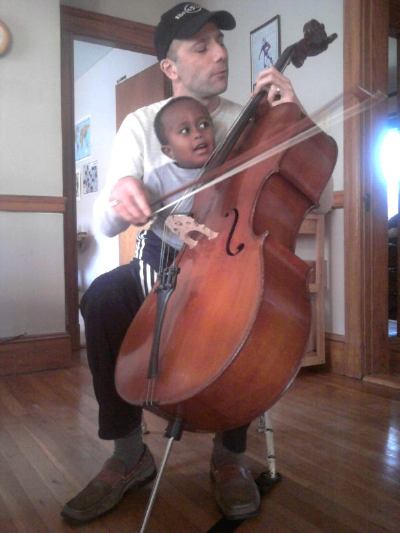The honeymoon is over. A’s been home barely a week, and the crying fits have begun in earnest. They happen mostly at naptime and bedtime, with occasional flare-up if Mommy “disappears” or when it’s time to leave the playground. We expected this, as crying is a normal response for a newly-adopted 2-3 year old to deal with fear, anger, frustration and grief. All we can do is hold him and make soothing sounds. And then, when it is over, Mr. P and I hold each other and make soothing sounds.
When he is in better spirits, A is quickly developing domestic independence. He insists on opening all of the doors when we leave or return to the house and is trying to master the safety gate we placed at the top of the front stairs, not realizing that the gate is to keep him in — yesterday, when the gate became dislodged from the wall, he was very concerned. In some ways, this toddler instinct to do everything himself is good. I can tell him to “wash your hands” and he doesn’t need me to move the stool in front of the sink, put soap in his hands, turn on the water and then dry his hands. Then again, the liquid soap is rapidly depleted and there’s never any hot water.
Today will be a test. It’s a rainy Saturday hence no trips to the playground to keep A amused. He likes the playground not just for the slides and swings; we’ve noticed that he tends to stare at the other kids a lot. Yesterday he sat on a bouncy car for five minutes, watching at a group of older kids running and frolicking amid the playground equipment. When similarly-aged kids move into his proximity and look at him quizzically, he becomes wary, quiet, motionless. Sometimes he’ll demand to go on the swing. Is he scared by his lack of language? Is it because these kids look different from him and all the kids he’s ever known? Is he trying to figure out how to behave? All we can do is keep taking him and hope they will become less threatening.
Food is still an issue. Yesterday I took him to the grocery store and showed him every healthful foodstuff within. He rejected apples, berries, carrots, cheese, meat, pasta, cereal, etc. etc. He is still on his banana-and-peanut butter kick, supplemented by bread, orange juice, and yogurt. He showed some interest in a can of lentil soup, so I bought it and attempted to give it to him for lunch. But he took the tiniest sip and freaked out. Last night we tried to get him to eat a piece of celery smeared with peanut butter and he refused. Nutritionally, his diet is somewhat sound, although we are waiting to talk to the international adoption doctor to see if his protruding belly is as a result of parasites or is simply fat (as the pediatrician suggested when I told him that A was feed five times a day, including two bowls of high-protein high-fat gruel). It’s hard to believe that we’ll have to put our adopted son from Ethiopia on a diet, but that’s what the pediatrician suggested — I’m sure he would not like to hear that A eats four bananas and a half-cup of peanut butter a day.
The English language acquisition is slow-going, although immersion will eventually win out. A doesn’t want to actively learn any words unless they directly pertain to his routine. He can vocalize shoes, socks, jacket, banana, door, peanut butter, and bubbles. Like other Ethiopian adoptees whose first language was Sidama, he has trouble with certain letter blends, as he is accustomed to hard consonants (airplane becomes “air-o-pu-lane”; the letter x is “ek-es.”) We look at a Curious George dictionary three times a day. We cannot, and I don’t think we’ll ever, get him to call cars, trucks, or trains anything than “machina.” Yesterday he was outraged when I kept saying “truck” when he pointed to a picture of a fire truck. The poor little boy is unsure of everything else in this world, but he was adamant that was truck was a machina.

